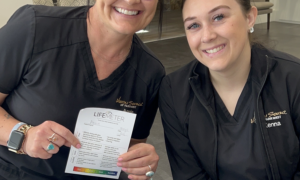
Dr. Hornberger with her practice’s opticians. She says there are specific actions you can take that make a huge difference to the per-patient revenue you are able to generate.
By Samantha Hornberger, OD
Oct. 12, 2022
Low reimbursements from managed care vision plans, combined with competition from online retailers and large optical chains, can add up to a low per-patient revenue. We have increased it from slightly over the industry average of $378 per comprehensive exam to over $550 revenue per exam in the last two years. Here is how we did it.
1. Increase (or start offering) Screening Scans & Images
For our small clinic, which sees 1,400 comprehensive exams per year, taking wide-field images on patients has resulted in a higher level of care delivered and a much higher profitability for our practice. More than 95 percent of our patients opt for this additional screening, which comes with an out-of-pocket fee that adds up to over $50,000 of additional revenue generated every year.
2. Check & Utilize Medical Benefits for Both Medical Care & Routine Care Whenever Appropriate
Often overlooked, many medical plans have built-in benefits for the routine exam in addition to a separate vision care plan. Not only should you be verifying medical insurance information and eligibility for every patient visit, but also checking if a routine benefit exists, as often medical plan reimbursement for routine exam and refraction is much higher than VCP reimbursement for the same services.
In our office, we use a benefit verification service that confirms both vision and medical plan coverage and provides us with a detailed summary of each. However, you can easily have a staff member in your office do this for your patients by checking the insurance carrier websites and calling the plan directly as needed. Having this information at your fingertips is also helpful when billing medically because then you know you have up-to-date information on co-pays and deductibles to share with your patient. This minimizes surprises when they have out-of-pocket fees owed once a claim has been processed and paid.
3. Consider Your Ideal Lens Options & Make that Your Standard
In our clinic every patient is automatically prescribed, and given price quotes for, high-quality anti-glare treatments for their lenses, and over 90 percent of our patients end up ordering their glasses with these treatments.
Have two options for PALs, good and best, and present them that way. Make sure the PAL lenses you choose to offer are not only great designs that work well for patients, but also are profitably reimbursed by vision insurance.
4. Offer Specialized Care
Consider what you are passionate about, or what you are most excited to learn. Examples of specialization that help patients while creating a profitable practice differentiator include dry eye/ocular aesthetics, specialty contact lenses, myopia management and vision solutions like Neurolens for computer vision and headaches.
As these services are usually not covered by insurance, or have much higher reimbursement (in the case of specialty contact lenses), every patient who benefits from these services increases your per-exam revenue significantly.
5. Spend More Time with Patients
It may seem counterintuitive, but increasing the amount of time you spend with each patient is good for both patients and practice. More time for educating and connecting often equates to higher revenue per patient. Patients are much more likely to purchase the products you have prescribed when they understand why you prescribed those products to them, and why they should buy them from you rather than online or at a chain optical.
Other Articles to Explore
Patients are also likely to become more compliant with your treatment plans for medical eyecare conditions when they understand what is at stake, how the treatments work and how those treatments will improve their lives. The trust factor you cultivate when spending quality time with each patient makes the difference in likelihood to return for care and make purchases from you.
Click HERE to read how Dr. Hornberger has improved care in enhancing patient education, and how this increased patient education is also highly profitable for her practice.
6. Only Prescribe Products & Treatments You Would Recommend to Your Own Family
If we would not recommend a product or treatment to our family, to those we are closest to, we don’t recommend it to our patients. When you have a policy of only prescribing products and services you truly believe in, your enthusiasm comes across to patients, and they usually take your advice.
 Samantha Hornberger, OD, is the owner of Bright Family Eye Care in Lawrenceburg, Ind. To contact her: doctorsam@brightfamilyeyecare.com
Samantha Hornberger, OD, is the owner of Bright Family Eye Care in Lawrenceburg, Ind. To contact her: doctorsam@brightfamilyeyecare.com



























